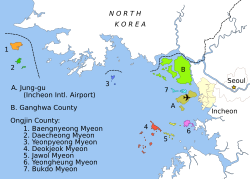
Incheon, formerly Jemulpo or Chemulp'o (제물포) until the period after 1910, officially the Incheon Metropolitan City, is a city located in northwestern South Korea, bordering Seoul and Gyeonggi to the east. Inhabited since the Neolithic, Incheon was home to just 4,700 people when it became an international port in 1883. Today, about 3 million people live in the city, making it South Korea's third-most-populous city after Seoul and Busan.

Jeju Province, officially Jeju Special Self-Governing Province, is the southernmost province of South Korea, consisting of 8 inhabited and 55 uninhabited islands, including Mara Island, U Island, the Chuja Archipelago, and the country's largest island Jeju Island. The province is located in the Korea Strait, with the Korean Peninsula to the northwest, Japan to the east, and China to the west. The province has two cities: the capital Jeju City, located on the northern half of the island and Seogwipo, located on the southern half of the island. The island is home to the shield volcano Hallasan, the highest point in South Korea. Jeju and Korean are the official languages of the province, and the vast majority of residents are bilingual in both languages.

Hwanghae Province was one of the Eight Provinces of Korea during the Joseon era. Hwanghae was located in the northwest of Korea. The provincial capital was Haeju. The regional name for the province was Haeseo.

Kaesong is a special city in the southern part of North Korea, and the capital of Korea during the Taebong kingdom and subsequent Goryeo dynasty. The city is near the Kaesong Industrial Region close to the border with South Korea and contains the remains of the Manwoldae palace. Called Songdo while it was the ancient capital of Goryeo, the city prospered as a trade centre that produced Korean ginseng. Kaesong now functions as North Korea's light industry centre.

Hampyeong County (Hampyeong-gun) is a county in South Jeolla Province, South Korea.
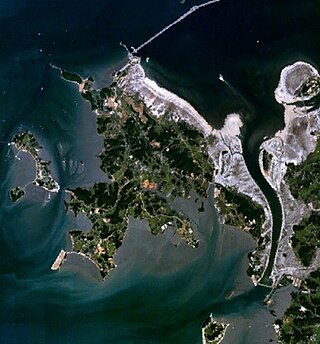
Daebu Island is an island in the Yellow Sea, within the municipal borders of Ansan city, Gyeonggi province. It has a population of roughly 7,114 people and an area of 41.98 km². Due to rising mudflats, the island has merged with neighbouring Seongam-do (Hangeul:선감도) and Tan-do (탄도). Administratively, the island today is divided into five dong: Daebubuk-dong (대부북동), Daebunam-dong (대부남동), Daebudong-dong (대부동동), Seongam-dong (선감동) and Pungdo-dong (풍도동). The predominant industries are tourism and fishing. The island is connected to the mainland in the south-east by road bridges, to Hyeong-do (형도) in the north-east by several routes due to land reclamation efforts, and to Seonjae-do (선재도) to the west by a further road bridge.

Baengnyeong Island is a 45.8-square-kilometre (17.7 sq mi), 8.45-kilometre (5.25 mi) long and 12.56-kilometre (7.80 mi) wide island in Ongjin County, Incheon, South Korea, located near the Northern Limit Line. The 1953 Korean Armistice Agreement which ended the Korean War specified that the five islands including Baengnyeong Island would remain under United Nations Command and South Korean control. This agreement was signed by both North Korea and the United Nations Command. Since then, it has served as a maritime demarcation between North and South Korea in the Yellow Sea. It has a population of approximately 4,329.
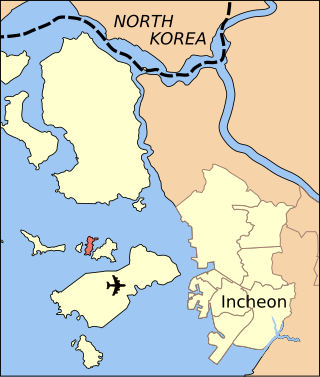
Sido, also known as Salseom, is an island off the coast of Incheon, South Korea. It has an area of 2.46 square kilometres and is currently inhabited by 238 residents, who mostly work in fishing. Yeondo-gyo, a bridge connecting Sido and Sindo, was completed in 1992.
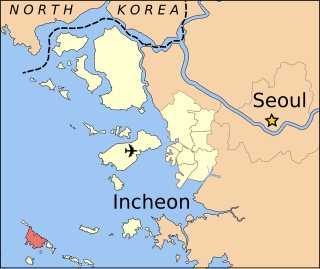
Deokjeokdo or Deokjeok Island is the largest island of Deokjeok-myeon in Ongjin County, Incheon Metropolitan City, South Korea.
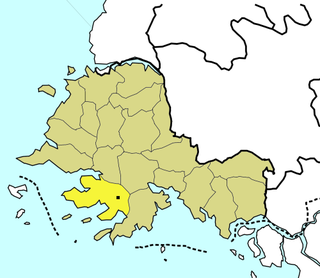
Ongjin County is a county in southern South Hwanghae Province, North Korea. It is located on the Ongjin Peninsula, which projects into the Yellow Sea.
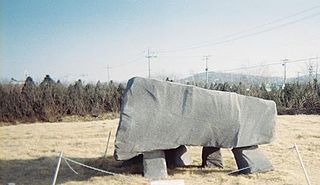
Ganghwa County is a county in the city of Incheon, South Korea. The county is composed of Ganghwa Island, and the minor islands around it.

Modo Island is a small island in Ganghwa Bay, off South Korea's west coast. It is part of Bukdo myeon, Ongjin County, Incheon Metropolitan City. Baemikkumi Sculpture Park is in the southern part of the island.

Ryongyŏn County is a county in western South Hwanghae province, North Korea. Its Yellow Sea coast is known for its natural environment and as an important habitat for plants and birds. Ryongyŏn was the first place in which Protestant Christianity was established in Korea, in the late 19th century.

Yeongheung Island is an island in the Yellow Sea, within the municipal borders of Incheon metropolitan city. It has a population of roughly 4000 people and an area of 23.46 km². The island is connected by road to neighbouring Seonjae-do (Hangeul:선재도) by the 1.25 km-long Yeongheung Bridge, which opened in December 2001. Administratively, the island today is divided into ten li: Nae-ri (내리) 1 to 7, and Oi-ri (외리) 1 to 3. Employment is provided through tourism, fishing, and the thermoelectric power station, largely built on reclaimed land on the south-west coast of the island.

Daecheong Island or Daecheongdo is a 12.63 km2 (4.88 sq mi), 7 km (4.3 mi) long and 6.3 km (3.9 mi) wide island in Ongjin County, Incheon, South Korea, near the Northern Limit Line. The 1953 Korean Armistice Agreement which ended the Korean War specified that the five islands including Daecheong Island would remain under U.N. and South Korea control. This agreement was signed by both DPRK and United Nations Command. Since then, it serves as a maritime demarcation between North and South Korea in the Yellow Sea.
Socheongdo or Socheong Island is a small 5 kilometer long and 3 kilometer wide island in Ongjin County, Incheon, South Korea, located in south Daecheong Island, near the Northern Limit Line. It is situated in the Yellow Sea, lying 200 km northwest of Incheon, 40 km southwest of the mainland of South Hwanghae, North Korea, and 200 km northeast of Shandong Peninsula, China.

"Hwanghae Province" or "Hwanghae-do" is, according to South Korean law, a province of the Republic of Korea, as the South Korean government formally claims to be the legitimate government of whole of Korea. The area constituting the province is under the de facto jurisdiction of North Korea.
Hwanghae dialect is a dialect of Korean spoken in North Hwanghae Province, South Hwanghae Province in North Korea, as well as the islands of Baengnyeongdo, Yeonpyeongdo and Daecheongdo in Ongjin County in South Korea. It may also be spoken among former Korean War refugees in cities such as Incheon.
Hambakdo or Hambaksom is an island in Yonan County, South Hwanghae, North Korea.

